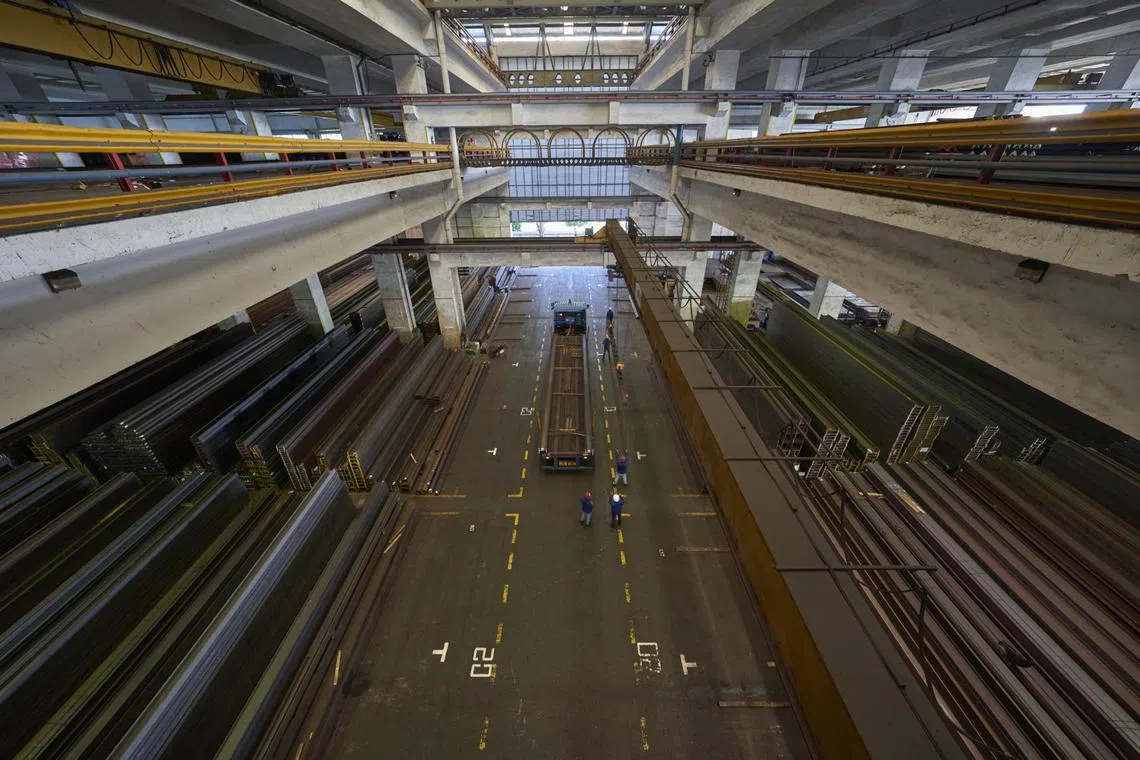S’pore firm Continental Steel plans to widen use of ‘green’ steel in construction
Sign up now: Get ST's newsletters delivered to your inbox

Continental Steel recently purchased its first shipment of certified low embodied carbon steel from the world’s second-largest steel-maker.
PHOTO: CONTINENTAL STEEL
Follow topic:
SINGAPORE - Continental Steel plans to expand the supply of low embodied carbon steel here in a move the company believes will help Singapore hit its ambitious net-zero goal by 2050.
The Singapore business, one of South-east Asia’s largest steel companies, recently purchased its first shipment of certified low embodied carbon steel from the world’s second-largest steel-maker.
Executive director Melvin Soh said the 6,000 tonnes of green steel bought from ArcelorMittal’s plant in Luxembourg was made entirely from scrap metal and forged by 100 per cent renewable electricity generated from solar and offshore wind.
Mr Soh told The Straits Times that in Singapore, steel is used mainly in the construction, infrastructure, energy and shipbuilding sectors.
“Oil, gas and shipbuilding is a more globalised business, but the construction and infrastructure segment is very localised, and the use of steel is significant,” he said.
Mr Soh, whose company recorded revenue of $80 million in 2021, said raw materials like concrete and steel accounted for roughly 60 per cent of all greenhouse gas emissions in a construction project.
A report released at the recent COP27 climate talks in Egypt said the building sector accounted for more than 34 per cent of energy demand and about 37 per cent of energy and process-related CO2 emissions in 2021.
It also noted that the sector needed to improve building energy performance, decrease the carbon footprint of building materials and increase investment in energy efficiency to cut emissions.
Mr Soh, who is also president of the Singapore Structural Steel Society, said: “In the spirit of trying to lower greenhouse gas emissions and to decarbonise, we as a company took a decision to start offering steel that is produced with lower carbon emissions.”
Carbon emissions from Continental Steel’s purchase from ArcelorMittal are significantly less pollutive, with emissions of 0.3 tonnes as opposed to 2.2 tonnes for steel produced in the traditional way of using blast furnaces powered by coal to melt iron ore.
As Singapore gears up for a hydrogen-powered economy,
“If we are going to build the containment vessels and develop the new infrastructure it would only make sense for all this to be built with low embodied carbon steel,” he added.
“And it is our view that the Government will probably prefer the use of low embodied carbon steel, otherwise there will be a contradiction of what they are trying to achieve, which is to deliver and develop cleaner energy.”

Executive director of Continental Steel Melvin Soh said that significant investments will be made in building the infrastructure required to support a hydrogen-powered economy.
PHOTO: CONTINENTAL STEEL
Mr Soh said data centres, which are said to have a high carbon footprint, can help to mitigate this by using lower embodied carbon materials when building a new facility.
“There are two aspects that would make it greener. One... is the energy it consumes, but the second part is its embodied carbon content utilised during the building and construction phase,” he said.
“Now if you use something like green steel, or steel with a lower embodied carbon, then you lower the emissions profile of that sector.”
He added that it would only be a matter of time before various industries start to look at how they can reduce their carbon footprint at the prefabrication stage of a new building.
Mr Christopher Davis, regional pricing director for metals at S&P Global Commodity Insights, said: “There is definitely growing interest in carbon-accounted steel in South-east Asia, in Singapore and beyond.
“It’s part of everyday industry conversations these days, which wasn’t always the case. Interest and use globally is probably strongest in Europe, as steel-makers are aggressively pursuing carbon-reduction initiatives there and government regulation increasingly influences corporate strategy.”
Mr Hector Forster, senior metals pricing editor at S&P Global Platts, said: “Long steel products such as rebars and beams made from melting recycling scrap, and using renewable power, will reduce the carbon emissions associated with construction, rather than using typical steel made from iron ore and coal-based processes.
“Low-emissions steel supplies will help reduce overall emissions associated with projects, which typically include cement and concrete, and other building materials with high carbon intensity.”
But he noted that new energy-intensive steel production using blast furnaces was actually growing in countries like Vietnam, Malaysia and Indonesia.
Mr Soh said the costs associated with the switch to low embodied carbon steel was around 2 per cent to 3 per cent, as opposed to purchasing material made with traditional methods.
He added that developers who decide to use more low embodied carbon materials, whether cement or steel, may be further incentivised as they will also be better placed to tap sustainable financing solutions.
“So there is definitely value in moving in this direction,” he said.
“Look, recycled steel is already commonplace in Singapore, but it is still not recognised for its value and it is not differentiated as a product, and with Continental Steel moving in this direction, we are enabling our customers to also take the next step and move forward in this green direction.”

